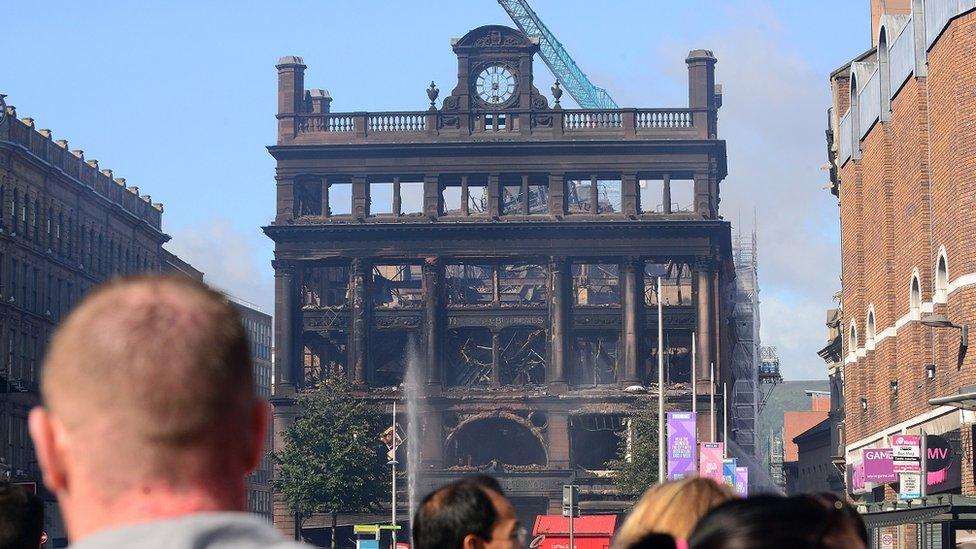Primark fire: A year on from Belfast's devastating blaze
- Published

The burning clock face at the top of the Bank Buildings became a memorable image of the fire
A year ago on a sunny, late summer morning a devastating fire broke out at one of Belfast's most prominent historic buildings.
The blaze at the Primark store in the Bank Buildings started on 28 August and burned for three days.
Fourteen businesses were unable to trade for months, and the cordon at Castle Place led to a drop in footfall in the retail heart of the city.
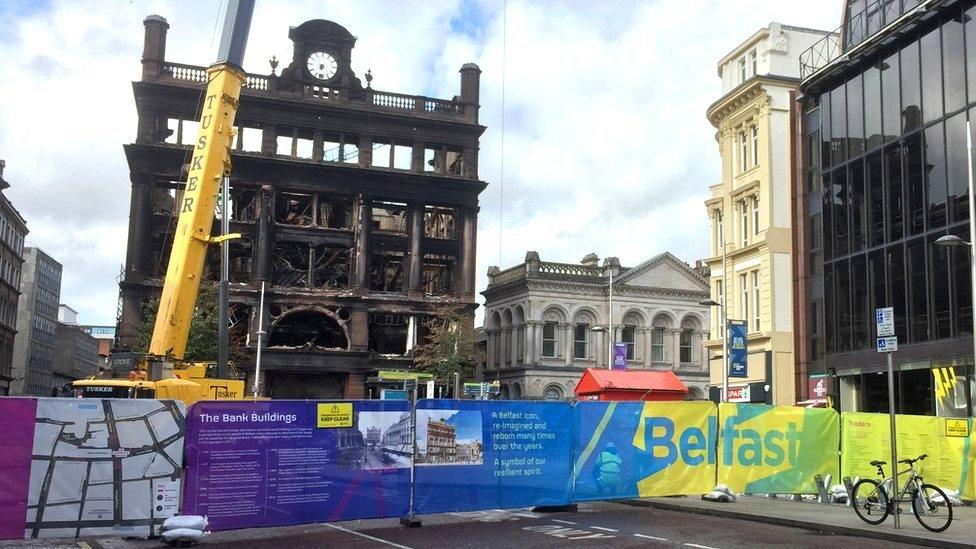
A cordon placed around the unsafe building caused problems for local traders
A year on, what do we know about the fire and its effects on Belfast?
What happened?
On Tuesday, 28 August, a fire broke out at the top of the five-storey Bank Buildings at about 11:00 BST.
Flames, clearly visible, leapt from the roof of the building while shoppers, and Primark staff, were quickly evacuated. The remaining floors were untouched by fire - but that was soon to change.
Within hours, the fire had spread to the bottom floor, completely destroying the building. Thanks to the quick evacuation, there were no injuries.
'It was a total disaster scene'
At the height of the incident more than 100 fire-fighters, and 14 fire appliances, were involved in tackling the blaze, including units from as far away as Armagh and Kilrea.
As they battled the fire throughout the day, onlookers stood in the surrounding city centre streets - kept at a safe distance by emergency personnel - as the blaze devastated the building.
Area Commander Aidan Jennings said it was a day he would remember.
"The size, scope and intensity of this fire provided many challenges and I can vividly recall that iconic image of the clock in Bank Buildings burning and the impact that had on our personnel working so hard to save the building," he said.
The fire burned for three days.
What caused the fire?
It said it was "not appropriate" to be "more specific about the actual cause of the accidental fire" because of a wider investigation by the Health and Safety Executive (HSE).
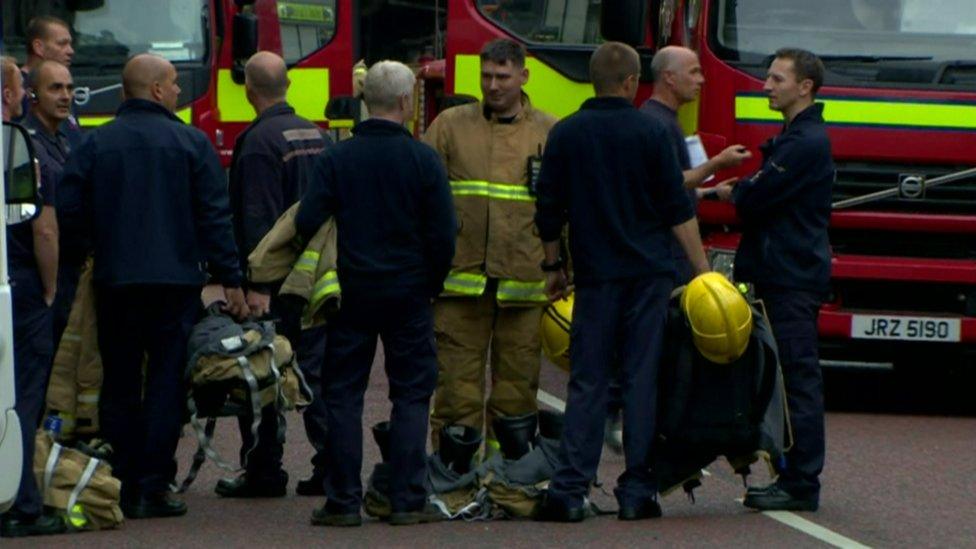
It took over 100 fire fighters to extinguish the flames
The HSE confirmed that its investigation was still ongoing.
At the time of the fire, the Primark store was being refurbished and extended at an estimated cost of £30m.
Why was the building so important?
The Grade B1 listed building was one of the city centre's most recognisable landmarks.
The original Bank Buildings was designed by Sir Robert Taylor and erected by Waddell Cunningham in 1785.
WH Lynn, who was also responsible for the city's Central Library and Carlisle Memorial Methodist Church, designed the new Bank Buildings in 1900.
How did the fire affect the city centre?
With the building completely gutted, and in danger of collapse, a safety cordon was imposed, which involved the closure of parts of Castle Street and Fountain Street.
However, traders on those streets - as well as others in the city centre - were hit by the restricted access and lower numbers of shoppers.
By October, it was reported that the fire had led to a "drastic dip" in shopping footfall.
According to Rajesh Rana, president of the Belfast Chamber, its impact was greatest in the northwest of the city centre, from Royal Avenue to Bank Square and Castle Street.

In May, The Prince of Wales and the Duchess of Cornwall visited the scene of the Primark fire
"Footfall in these streets was down by about a third, less so in other parts of the city," he said.
He added that the fire had the effect of "galvanising support and prompted a coordinated action plan for city recovery," led by Belfast City Council.
As the months went by, access improved - a tunnel opened in November that allowed shoppers to walk past the damaged building, with shipping containers in place in case it collapsed.
By December, in time for the busy Christmas trading period, a temporary walkway opened allowing eight businesses to pull their shutters back up.
The cordon was reduced again last February, allowing pedestrians to walk between Castle Street and Fountain Street after more than six months of restricted access.
Were people satisfied with the response to the fire?
The Lord Mayor of Belfast, John Finucane, said it had been "a challenging 12 months for our city centre traders, particularly those who were directly impacted by the necessary cordon and road closures that resulted".
Looking to the future, Cllr Finucane said the council "can't take our foot off the pedal".

Work is continuing to secure the building and ensure it remains safe
"We have an opportunity now, not just to go back to how things were, but to be creative about the future of our city centre and examine how council can help support its development to cater for everyone's needs including traders, pedestrians, cyclists and public transport providers."
Mr Rana, from the Belfast Chamber, said that the fire helped "increase coordination across the individuals and agencies working in central Belfast and that relationship is continuing to strengthen".
He said the measures taken to increase footfall ahead of last Christmas worked, and that the recovery plans have continued into this year.
What about the building?
While the fire completely destroyed the building's interior, its famous facade remained largely intact.
At the time, the fire service said it was "optimistic" it could be saved and there were soon plans put in place to secure the structure with a view to retaining the face of the historic building.
Plans were approved to salvage and rebuild much of the external structure, but the work requires a 45m (50yd) safety zone in front of the building, in case of sudden collapse.
The Bank Buildings are currently under wraps, made secure with shipping containers and scaffolding with work being carried out to secure the edifice and ensure it remains safe.
Primark has applied for planning permission for its renovation proposals, including the return of the clock face.
The application was received by Belfast City Council last week and will be considered by its planning committee.
Meanwhile, the company was able to reopen its store at the rear of the Bank Buildings site last December, where it had been building an extension before the fire.
- Published20 June 2019
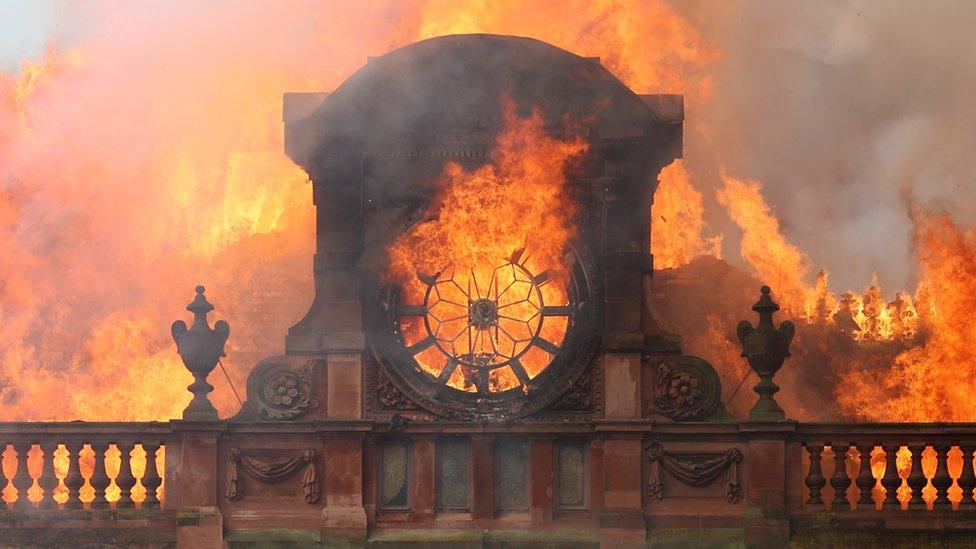
- Published27 February 2019
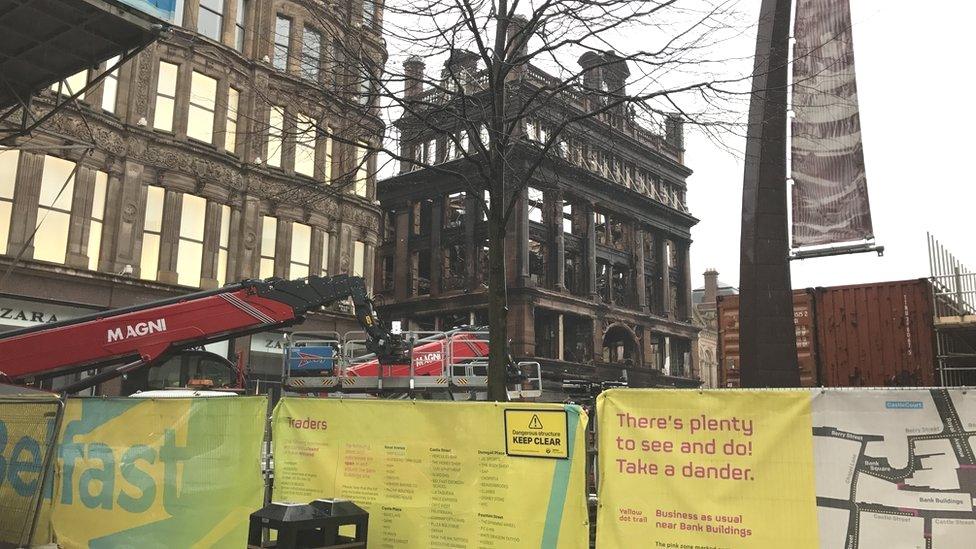
- Published12 November 2018
